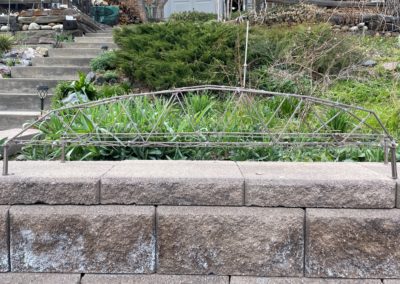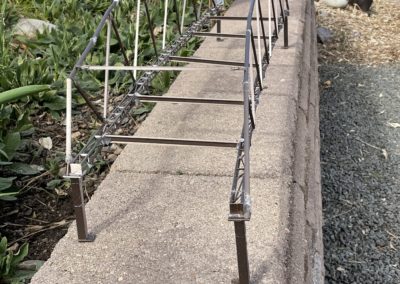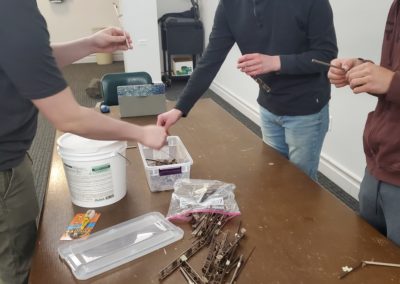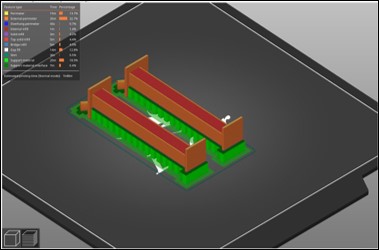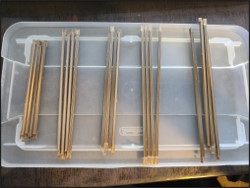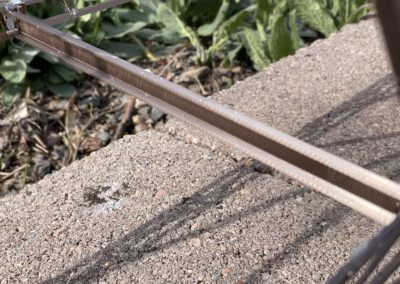AISC Steel Bridge
Overview
Heavy flooding along the Missouri River has threatened the functionality of Katy Trail in the historic Katy Trail State Park. The American Institute of Steel Construction has challenged students nationwide to design and fabricate a 1:10 scale model of a steel bridge capable of supporting pedestrian traffic, bicyclists, and equestrians as well as park service and emergency vehicles.
The design solution provided is a steel over-truss bridge that is aesthetically pleasing, optimizes weight to stiffness, and has an efficient construction time. The bridge’s truss component features a nearly symmetrical layout of bridge members on either side of the deck, resembling the Rocky Mountains. The stringers’ main component revolves around cross bracing throughout the length of the bridge which serve to redirect load and to improve the stringers’ rigidity against significant deflections. The footers are skewed and utilize plates on either end of a square HSS member to provide a strong base for the bridge.
Using RISA3D modeling, the bridge’s performance was analyzed under several different loading conditions, resulting in deflections within the required limits. The final prototype is a 1:50 scale of the real bridge to be built in Katy Trail State Park, made from 3D printed members.
This animation shows the AutoCAD bridge model with the construction sequence developed by the team.
Live Zoom Chat
Use the link below to join us live from 8:00 – 10:30 a.m. on April 29.
Please use passcode: aisc2021
Or iPhone one-tap: 16699006833,99279916360# or 12532158782,99279916360#/
Or Telephone:
Dial: +1 669 900 6833 (US Toll) or +1 253 215 8782 (US Toll)
Meeting ID: 992 7991 6360
Team Members
- Matthew Baum
- Sam Cabrera
- Neo Huang
- Jeremiah Martinez
- Miranda Schiffbauer
- Nick Talamante
The Client
- Kiewit
Acknowledgements
Project Advisor: Dr. Kristy Csavina
Technical Advisor: Prof. Jeff Holley
Donations Made by: Zimkor, Inc, American Institute of Steel Construction (AISC)
Special Thanks to Bruce Yoshioka and Steve Reed!
Video
Elevator Pitch
We are the AISC Student Steel Bridge Competition Team, Trussworthy Engineering! We are comprised of six members, with varying backgrounds in bridge and steel design and construction. Due to a combination of COVID restrictions and unforeseen circumstances, the team was unable to fabricate the steel bridge and participate in the Regional Competition this year. The team has instead produced a 1:50 scale model of our bridge, made from 3D printed members. The team also created a detailed RISA3D model to model the steel material, simulate load conditions and obtain member force and deflection results.
The final bridge design includes unique concepts in the truss, stringer and connection designs. The over-truss has truss members resembling mountains from a side view and features male-female connections. The stringer members are composed of three different lengths with cross-braces throughout. Overall, the RISA3D model bridge adheres to the deflection limits in the AISC Competition Rules.
Design Approach
To establish a foothold in the design process and the iteration of project ideas, the design team began by reconstructing and examining the design and the fabricated steel bridges produced by last year’s teams from Colorado School of Mines. After reconstructing a previous teams’ bridge, the team decided on favorable and undesirable design concepts. The experience with the previous year’s designs and fabricated models proved especially useful as their problem statement, assumptions and constraints were identical to those for this year’s Student Steel Bridge Competition. The three major components of the team’s bridge design were the truss, stringer and connections. The final AutoCAD drawing of the design is shown below.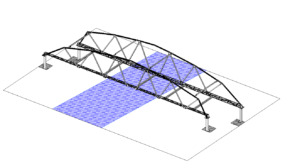
From an aesthetics standpoint, the team decided early on to develop an over-truss design as opposed to an under-truss or deck bridge. Preliminary research and the hands-on construction of one of last year’s bridges proved that an over-truss would provide sufficient strength, was the most favorable for the constructability constraint, and allowed for helpful adaptations to be made such as truss member angles and connection points. The first iterations included different truss geometries such as a rectangle, triangle, and what is referred to as a “mountain” truss that were modeled in RISA 3D. The team moved forward with the mountain truss design. This design was aesthetically appealing and had a reasonable number of members to hold the load but not add unnecessary weight. Striking a balance between stiffness and weight was the primary focus during early iterations, with RISA3D being the main modeling program to aid the team’s efforts.
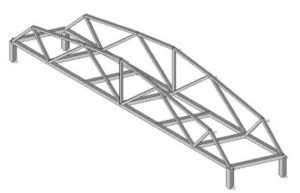
Early iteration of the “mountain truss”.
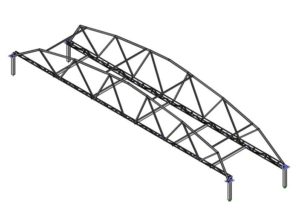
Final design of the truss.
For the stringer design, the team looked at the required load cases and determined that the stringer had to resist loads vertically and laterally. The initial concept consisted of three round HSS bars running along the bridge length, laid out in an angle or “L” shape. After preliminary Solid Works analysis, it was determined that the round bars were not sufficient in resisting both planes of loading. Therefore, a square cross section for bars were needed. Cross bracing was added to increase the capacity of stringer in both shear and bending. The orientation of the stringer is also important as by placing the stringer with the wider section on top and on the inside of the bridge we can guarantee the utilization of all three members for the vertical and horizontal load cases.
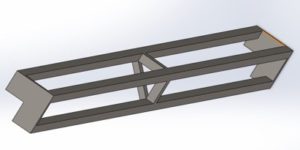 Early iteration of stringer member.
Early iteration of stringer member.
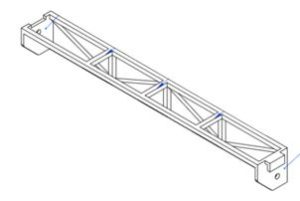 Final design of stringer member.
Final design of stringer member.
Several connections were designed for the bridge, including welded connections internal to a member and bolted connections from member to member. The team had many design sessions dedicated to hand sketching different connection ideas, and as the design developed, they were drawn in AutoCAD. The team was limited to members sized at 3′-6″ x 4″ x 6″, so unique connections were made in areas such as the over-truss and the stringers. The image at right shows the complex connection at the footer to allow for the truss and stringer to both attach to the footer, and meet the clearance requirements of the bridge deck.
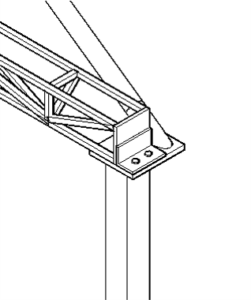
Footer details, with truss welded on the outside of the stringer member.
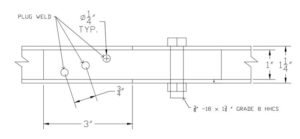
Male-female connection for adjacent over-truss members.
Design Solution
As a competition-based design project, the concept for the steel bridge model needed to satisfy the specifications defined per the challenge’s rules, but the performance of the model also depends largely on the extent to which the design promotes a sophisticated and intentional ease of fabrication and construction. Consequently, the main areas of focus in the design of the bridge include efficiency in construction time and cost and structural integrity against applied loads.
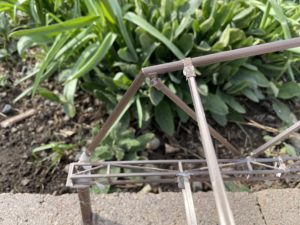
Truss connections on assembled bridge model.
The bridge’s truss component features a nearly symmetrical layout of bridge members on either side of the deck though the inverted angles on the ends of the truss accommodate for the uneven distribution of the footings’ placement. Round HSS members build the overarching frame of each truss to allow for a stable body while still accounting for the goal of limited self-weight. The ends of the trusses feature a male-female connection as a means for securing the truss to a round HSS member that is welded to the corresponding footers to effectively reduce the construction time. The ends of the stringers also meet at this conjunction above the footers to condense material without impeding the ability to secure connections during construction.
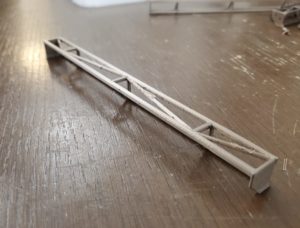
3D printed stringer member.
The stringer consists of three square bars with cross bracing throughout the length of the bridge which serve to redirect load cases and to improve the stringers’ rigidity against significant deflections. Adjacent stringers are connected via hooks on the end plates that align the bolt-holes for two through-bolts.
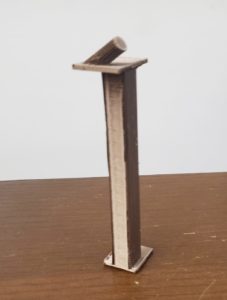
3D printed footer member
The footer design has undergone significant development to allow for a secure connection to other components while still being able to withstand the impending load cases. For simplicity and the resulting ease of construction, the footers will combine plates on either end of a square HSS member. The goal of this format is to conform to the competition’s specifications for lightness and cost efficiency while supplying proper foundational support for the bridge as a whole.
The RISA3D deflection results for the 1:10 scale steel bridge are within the limits provided to by the competition rules, and it has a total weight of 292 lbs. Under the vertical load, the vertical deflection was 0.57″, with a 2″ horizontal side sway. Under the horizontal load conditions, the horizontal deflection was 0.52″. Hand calculations were also performed for the connections with the highest tensile and shear forces on the bolts. The 3/8″ diameter, 1-1/4″ length Gr. 8 hex head cap screws were found to be sufficient for all the bridge’s connections. Below is a picture of the final prototype – the bridge model made of 3D printed members.
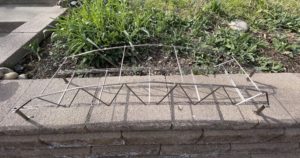
1:50 scale bridge model.
Next Steps
In the event that our project is continued by a future team, the fabrication of the actual steel bridge could be completed. We produced shop drawings as if we were able to fabricate, but these would need to be revised and adjusted for fabrication tolerances. We’d also like to impart some lessons learned that next year’s steel bridge team can learn from. First, we learned to not to be afraid to ask for technical advice and multiple opinions from industry/academic experts. As a team, we struggled with certain aspects of design for several days when we could have reached out to a professor to resolve our challenges more efficiently. Reaching out to others is an important part of working in industry, so learning to professionally engage someone to get specific answers is a key takeaway from the project. Also, it is important to consistently communicate with clients and external vendors. Sometimes one has to be quite persistent in order to keep the project on schedule, which is important to both Senior Design and future careers.
Meet the Team
Matthew Baum

Matthew is a Civil Engineering Senior originally from North Carolina who has made Colorado his permanent home. He has interned with Parsons Construction Group for two summers as a heavy civil construction engineering intern and has accepted a full-time position with Martin/Martin Consulting Engineers. He enjoys building structures and other objects out of wood, brick, and concrete. His hobbies include remodeling homes, modifying and repairing cars, hiking, snowshoeing, and backpacking with the team mascot, Luna the Siberian Husky.
Sam Cabrera
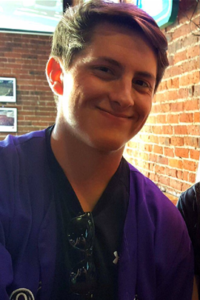
Samuel is a graduating senior at the Colorado School of Mines who hails from Pueblo, Colorado. Coming from a structural background, Sam is going to work for a structural inspection firm that specializes in the utilization of scuba diving to perform underwater assessments of bridge and dam components. In his free time, he enjoys rock climbing, hiking, cooking and the outdoors. Some interesting facts about Sam are that he has never eaten a pear, he is afraid of Giraffes, and he can hold his breath through the entire Eisenhower Tunnel.
Neo Huang
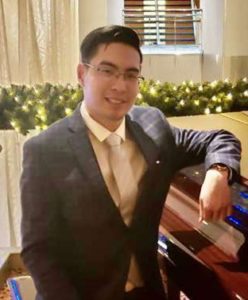
Neo is a Civil Engineering major from Phoenix Arizona. He enjoys gaming with friends, reading/watching anime related material, and 3d printing props from his most favorite movies. Some interesting things about him are that he has been hit with a shotput, ridden a horse, and been slapped by a dolphin. In the future he plans to work in construction and more specifically with the VDC department.
Jeremiah Martinez

Jeremiah is a civil engineering major from Littleton, Colorado. His primary interests involve structural engineering and land development, and he is hoping to enter the field of project management upon graduation in May 2021. Outside of academics and job hunting, he enjoys reading about current events, watching movies, hiking through Colorado’s great views, and traveling back and forth between California and Colorado to visit family members.
Miranda Schiffbauer
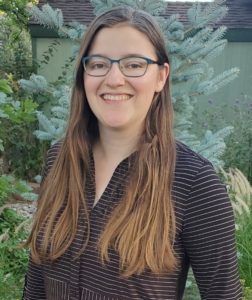
Miranda served as the Project Manager for the team. She is a Civil Engineering student graduating in May 2021, with plans to pursue her Masters at Mines. She was born and raised in Arvada, Colorado. Her engineering focus is structural engineering, and she has previous experience interning with Merrick & Company. Miranda is the President of the Mines Club Lacrosse team. Outside of school she enjoys golfing, hiking, playing guitar, reading, and watching her favorite sports teams.
Nick Talamante

Nick Talamante is a graduating senior, majoring in Civil and Environmental Engineering in May 2021. Growing up in Edith, CO, a community outside of Pagosa Springs, CO, Nick loves being in the great outdoors. His passions include hunting, horseback riding, and especially fly-fishing. Being raised with a strong residential construction background, Nick has fallen in love with all kinds of construction. He was fortunate enough to accept a full-time position with Barnard Construction Company and is excited to see what jobs lie ahead.
Luna
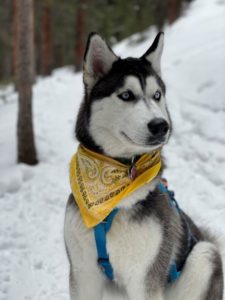
Luna the Siberian Husky is the team’s mascot and is a Good Girl major at Dad’s Doggo Training. She is from Cuchara, Colorado. She loves meeting anything that moves, engaging her thrusters in the snow to zoom like a rocket, chasing and being chased, training, babies, sticks, and squirrels. Luna is a support dog that does not like when humans are upset, stressed, or not feeling good.

